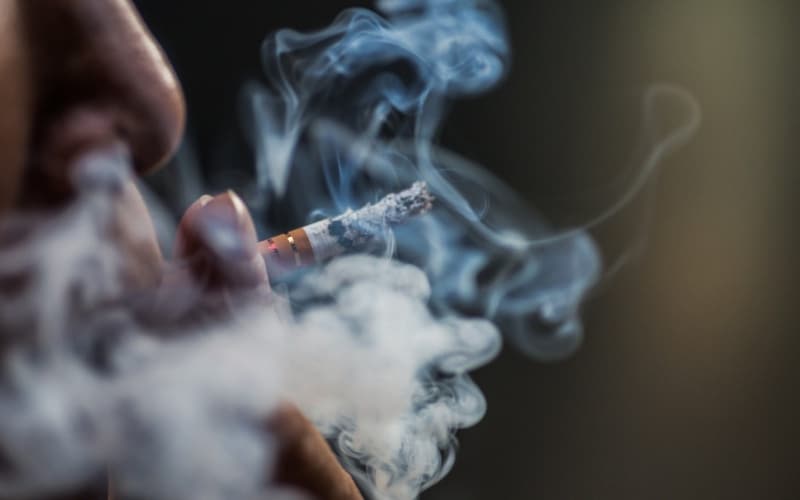Secondhand smoke is also known as passive smoke, involuntary smoke, or side-stream smoke. This is the smoke emitted when primary smokers use marijuana, cigarettes, cigars, and other tobacco products, and are inhaled involuntarily by other non-smokers.
Passive smoke is indeed as detrimental to a bystander’s health as it is to the smoker. The mythical element to this fact, however, is that a non-smoker would test positive in a drug test after secondary exposure.
Nonetheless, depending on factors such as drug potency, period of exposure, and room ventilation, there may be traces of the drug’s compounds in the non-smoker’s urine, but not enough to fail a drug test.
According to John Hopkins University, a urine test could show positive results after long hours of exposure to secondhand smoke in a poorly ventilated room with active smokers. Even so, such a scenario is highly unlikely.
Findings from the two most commonly smoked drugs;
Cannabis/marijuana
Although there are no published studies to prove that a positive drug test could result from secondhand smoke, a study conducted using six casual cannabis smokers and six non-smokers showed an irrefutable outcome.
The experienced smokers were placed in an unventilated chamber, smoking marijuana with different concentrations of delta-9-tetrahydrocannabinol (THC), a chemical compound in the cannabis plant that causes the ‘high’. The six nonsmokers sat next to them.
In another session, all participants were taken to a ventilated room. After numerously testing the non-smokers’ urine in the following 34 hours after exposure, only one participant portrayed high levels of THC exceeding the typical levels of detection. This was visible about six hours after exposure.
A more sensitive drug test was also used on this participant’s urine sample and THC was detected in very minimal quantities but only viable for the next 24 hours. The results of the non-smokers in the ventilated room were nowhere near the threshold for a positive test.
Tobacco
Nicotine is an addictive substance in all tobacco products. It is not uncommon to undergo pre-employment mandatory nicotine drug tests while joining private institutions or holding federal positions. Some health and life insurance institutions also have this as a requirement.
As reported by the World Health Organization (WHO), around 15% of the global population smoked tobacco, by 2015. This number has skyrocketed to a good 20%, making 1 in every 7 adults a tobacco smoker, as of 2020.
The above data implies there are as many secondhand smokers as there are primary smokers who almost always pass the drug test. Read on further to understand why.

So how does the drug test work?
Whether done via urine, saliva, hair, or blood screening, all drug tests have a threshold limit. This means that the test will measure the concentration of a substance in your body. If it is above the threshold limit, then the results are positive.
Cut-off/threshold limits are usually high enough to eliminate the possibility of a secondhand smoker failing the test. This explains why it is highly unlikely for secondhand smoke to show up on drug tests.
The drug test provides qualitative and quantitative screening. That is, it identifies the substance in your system, measures its concentration, and tells whether you are a frequent smoker, or you just recently inhaled the substance in question.
In addition, the method of testing can influence the results obtained. Therefore, we’ll look at which method is most accurate and why.
What is the most accurate method of testing?
Urine testing
The most common method of testing is urine screening. Besides making collection easier, urine has a high drug concentration and a longer window of detection, approximately 24-72 hours after last use because the drug has to be metabolized after consumption.
However, urine samples are prone to adulteration due to unobserved collection and thereby altering the outcome.
Saliva testing
Mouth swabs are used in the detection of recent consumption, which is in less than 24 hours since the last usage. In the case of cannabis use, it is detectable in less than 4 hours. THC in cannabis is also not detectable as a metabolite but as a compound in saliva.
Although it has a shorter detection window, saliva testing is the most sensitive method to rule out any suspicions of recent smoking.
Unlike urine testing, saliva testing is 100% observed, eliminating the risk of tampering or cheating.
Hair testing
Hair samples are reliable for the long-term detection of tobacco products. It can determine drug use for up to three months since last use. Under high intoxication, nicotine can be detected for up to 12 months in hair follicles.
Technically, there is no better testing method than the other. Each of these methods (and more) have their limitations and benefits. Therefore, the most appropriate method is selected with regard to the situation at hand.
Health effects of secondhand smoke
According to CDC, secondhand smoke carries more than 7000 chemicals, hundreds of which are toxic and about 70 of them cancerous.

Exposure to secondhand smoke predisposes non-smokers to the following conditions:
- Heart diseases. Inhaled passive smoke interferes with the normal functioning of the heart and vascular systems by damaging the lining of blood vessels and thus limiting the flow of blood to vital organs. Limited blood flow to the heart can cause cardiac arrest since there is not enough oxygen and nutrient circulation to the blood cells.
- Respiratory diseases. Adults and children exposed to secondhand smoke are at a higher risk of developing asthma attacks and other frequent respiratory infections.
- The Center for Disease Control and Prevention statistics show that persons exposed to secondhand smoke increase their chances of developing lung cancer by 20-30%. Tobacco smoke can also cause breast cancer, leukemia, and lymphoma.
- Pregnant women are also at risk of delivering premature babies due to secondhand exposure.
References
